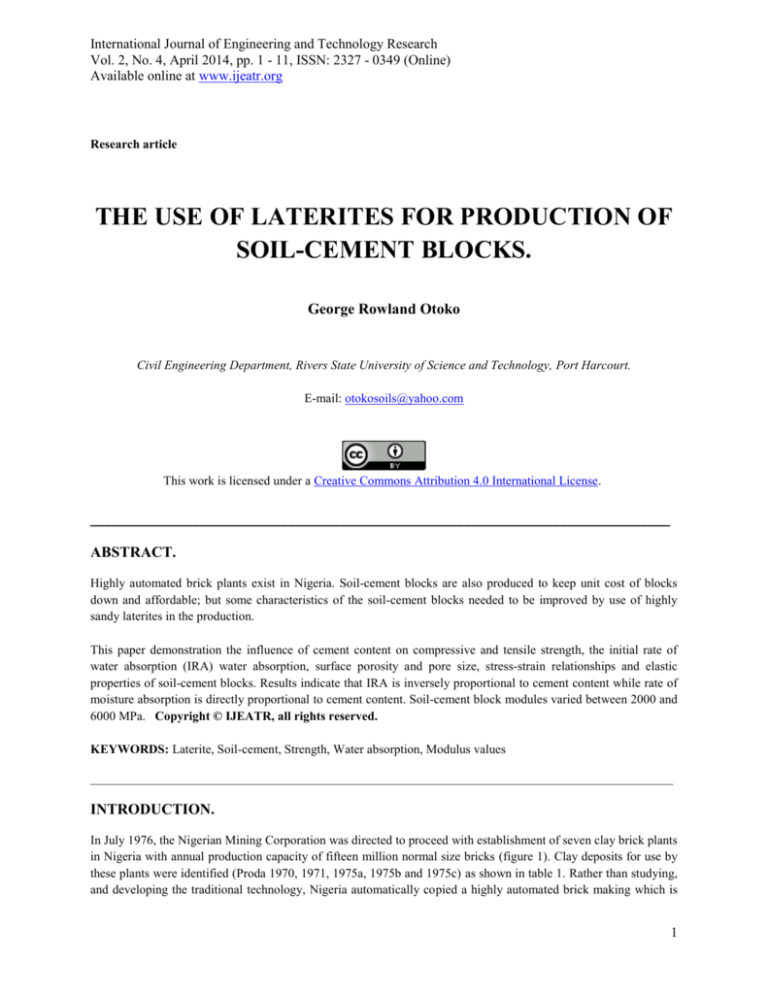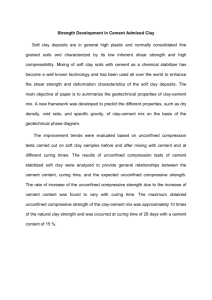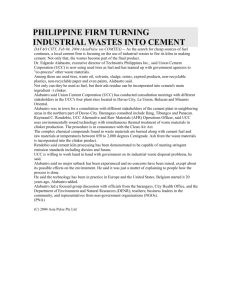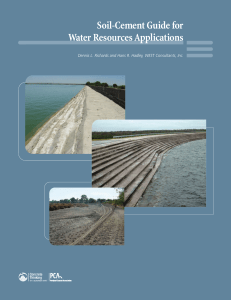
International Journal of Engineering and Technology Research
Vol. 2, No. 4, April 2014, pp. 1 - 11, ISSN: 2327 - 0349 (Online)
Available online at www.ijeatr.org
Research article
THE USE OF LATERITES FOR PRODUCTION OF
SOIL-CEMENT BLOCKS.
George Rowland Otoko
Civil Engineering Department, Rivers State University of Science and Technology, Port Harcourt.
E-mail: otokosoils@yahoo.com
This work is licensed under a Creative Commons Attribution 4.0 International License.
__________________________________________________________________
ABSTRACT.
Highly automated brick plants exist in Nigeria. Soil-cement blocks are also produced to keep unit cost of blocks
down and affordable; but some characteristics of the soil-cement blocks needed to be improved by use of highly
sandy laterites in the production.
This paper demonstration the influence of cement content on compressive and tensile strength, the initial rate of
water absorption (IRA) water absorption, surface porosity and pore size, stress-strain relationships and elastic
properties of soil-cement blocks. Results indicate that IRA is inversely proportional to cement content while rate of
moisture absorption is directly proportional to cement content. Soil-cement block modules varied between 2000 and
6000 MPa. Copyright © IJEATR, all rights reserved.
KEYWORDS: Laterite, Soil-cement, Strength, Water absorption, Modulus values
_____________________________________________________________________________________________
INTRODUCTION.
In July 1976, the Nigerian Mining Corporation was directed to proceed with establishment of seven clay brick plants
in Nigeria with annual production capacity of fifteen million normal size bricks (figure 1). Clay deposits for use by
these plants were identified (Proda 1970, 1971, 1975a, 1975b and 1975c) as shown in table 1. Rather than studying,
and developing the traditional technology, Nigeria automatically copied a highly automated brick making which is
1
International Journal of Engineering and Technology Research
Vol. 2, No. 4, April 2014, pp. 1 - 11, ISSN: 2327 - 0349 (Online)
Available online at www.ijeatr.org
capital intensive and therefore, kept the unit cost of bricks too high for the average Nigerian to afford. The Nigerian
Building and Road Research Institute (NIBRRI) thereafter introduced the soil - cement blocks using manual press
for its production. This kept unit cost of the soil cement block down and affordable, but some characteristics of the
soil-cement blocks needed to be improved by use of highly sandy laterites; which are already being used as fills in
Nigeria (Otoko 2014).
Figure 1: Brick Plants In Nigeria.
Key
Brick plants owned by the Nigerian Mining Cooperation.
Bricks plants owned by Private entrepreneurs.
Table 1: Principal clay deposits in Nigeria.
S/No
1.
2.
3.
4.
5.
6.
7
8.
9.
10.
State
Benue and Plateau State
Imo, Ebonyi, Enugu and Anambra States
Kano State
Lagos State
Edo and Delta States
Borno State
Sokoto State
Rivers State
Akwa Ibom and Cross River State
Ogun State
Location of principal deposits
Jos, Ropp and Markurdi areas
Enugu, Ezi Akwu, Ekwe and Agbahara
Kano and Rimi areas
Epe, Ikorodu and Badagry areas
Benin city, Sapele and Ugheli areas
Maiduguri and Gombe areas
Sokoto and Kuban village
Port Harcourt and Andoni areas
Ekpene Obom area
Abeokuta and Ijebu-Ode areas
2
International Journal of Engineering and Technology Research
Vol. 2, No. 4, April 2014, pp. 1 - 11, ISSN: 2327 - 0349 (Online)
Available online at www.ijeatr.org
Lateritic weathering products derived from rock types of various parts of Nigeria may not be the same. The laterites
of the geological zone 1 (Dry flat country) of the Niger Delta, Nigeria is used for this study (see fig. 2)
Imo State
Delta State
Abia State
Akwa
Ibom
State
Figure 2: Geomorphologic Zones of the Niger Delta, Nigeria.
Previous work on the geological study of laterites in Nigeria dwells mainly on their distribution, classification, depth
extent, general nature and formation (Faniran 1970, 1972, 1974 and 1978; Adekoya et al 1978).
Although much work has been done on the geotechnical study of laterites (Ola 1978, 1980a, 1980b; Alao 1983,
Otoko 1985, 1987, 1988, 1997 and 2000) most especially in connection with foundation and embankment problems,
little or no attention has been paid to compacted laterites (Omine and Yasufuku 2005, Oota and Iba 2009).
This paper therefore, focuses on the use of laterites for soil - cement production. Currently, more than 100 types of
soil - cement making machines are available in the world market (Kiren 1986). More details on soil - cement block
technology can be found in Walker at al 2000; Houben and Guillaud 1994; Walker 1999, 2004; Middleton 1952;
Dept of HUD 1955; Fitzmaurice 1958; Lunt 1980; Heathcote 1991; Venkatarama and Jagadish 1995; Walker and
Stace 1997; Venkatarama and Jagadish 1993.
The major findings from these studies include the fact that ideal soil for soil-cement block production must be
sandy, containing predominantly non - expansive clay minerals (like Kaolinite) and having sand content ˃ 65% clay
fraction of about 10% and dry unit weight ˃ 18kN/m3. However, there is additional need to study the strength,
absorption characteristics and elastic properties of the soil-cement blocks using sandy laterites and which is the
subject of this study.
3
International Journal of Engineering and Technology Research
Vol. 2, No. 4, April 2014, pp. 1 - 11, ISSN: 2327 - 0349 (Online)
Available online at www.ijeatr.org
EXPERIMENTAL PROCEDURES.
Manual operated block making machine was used to produce 305 x 143 x 100mm soil-cement blocks. The blocks
are stacked and then cured by spraying water for 28days, and thereafter, allowed to dry in the laboratory for 30days
before tests were carried out on them.
Figure 3: Particle Size Distribution for Sand, Laterite Soil and Reconstituted Soil.
Locally available reddish brown laterite obtained from Elelenwo area of Port Harcourt (fig. 2) was used for the
block production. Its clay fraction was 20%; while the liquid limit, plastic limit and plasticity index of the soil was
43.5%, 20.8% and 22.7% respectively. As the clay content was more than 10%, it became necessary to reconstitute
the clay by adding natural bed sand (specific gravity of 2.50 and clay fraction of 5%) to it, in order to bring down the
clay fraction of the mix (mix ratio of soil to sand was 1.2 by weight). The resulting mix contained 9% clay, 18% silt
and 73% sand as shown in the grain size distribution of the laterite sand and the reconstituted soil - sand mixture
(fig. 3).
The soil-cement blocks designated B1, B2, B3 and B4 were produced with 6%, 8%, 10% and 12% cement content
respectively; while the following characteristics were examined: Initial rate of absorption, water absorption, rate of
moisture absorption, wet and dry compressive strength, flexural strength, direct tensile strength, stress-strain
characteristics of the block.
(i)
Initial Rate Of Absorption (IRA) And Water Absorption.
Determination of the initial rate of absorption for soil cement blocks and the water absorption of the blocks were
determined in accordance with ASTM C 67 - 94 (1995) and BS 3921 (1985) respectively.
4
International Journal of Engineering and Technology Research
Vol. 2, No. 4, April 2014, pp. 1 - 11, ISSN: 2327 - 0349 (Online)
Available online at www.ijeatr.org
(ii)
Rate Of Moisture Absorption.
The soil-cement blocks were dried in an oven at 60 ̊c and then allowed to cool down to ambient temperature. The
dry weight of the block is measured before soaking it in water for 0.5, 1, 2, 5, 10, 15, 30, 120 and 140 minutes.
Thereafter, the wet weight of the blocks were measured. Calculation of the percentage saturation is with respect to
dry weight. The soaking duration are plotted against the block water absorption in fig. 4.
(iii)
Wet Compressive Strength
The soil-cement blocks were soaked in water for 48hrs prior to testing. Standard calibrated crushing machine was
used to crush the saturated blocks of 305x143x100mm to failure, in order to determine its wet compressive strength
in accordance with BS 1881 - 116 : 1983 and defined by P = F/A
Where F is the failure load and A is the cross sectional area of the specimen.
Figure 4: Variation of Water Absorption with Soaking Duration.
(iv)
Flexural Strength.
For flexural strength test, the 48 hours soaked blocks were tested with point loading in accordance with BS EN
12390 - 5 : 2009.
(v)
Tensile Strength.
For tensile strength tests, the 48 hours soaked blocks were pulled in direct tension with the help of steel brackets in a
universal testing machine.
5
International Journal of Engineering and Technology Research
Vol. 2, No. 4, April 2014, pp. 1 - 11, ISSN: 2327 - 0349 (Online)
Available online at www.ijeatr.org
(vi)
Stress-Strain Characteristics.
The soil-cement blocks were soaked in water for 48 hours prior to testing. Standard calibrated crushing machine was
used at a constant piston displacement of 1.25mm per minute. The stress strain characteristics is thus determined.
Two points were fixed on the longitudinal face of the block from where the longitudinal strains were measured over
a gauge length of 200mm.
RESULTS AND DISCUSSIONS.
Soil-cement blocks of laterite soil-sand mixes with four different cement contents (6%, 8%, 10% and 12%) were
examined and various characteristics like compressive strength, flexural strength, tensile strength, IRA, water
absorption and stress-strain characteristics of the soil-cement blocks discussion as follows:
(i)
Strength And Water Absorption Of The Soil-Cement Blocks.
Table 2 gives the test results for all the parameters tested together with the mean values and the range (minimum and
maximum) or coefficient of variation; while fig. 5
shows the variation of compressive strength with
cement
content; while fig. 6 shows the variation of flexural and tensile strength of the blocks with cement content and fig. 7
shows the variation of the IRA values with cement content of the block. All these and table 2 show that: wet
compressive strength of the soil-cement is in the range of 3.15MPa to 7.20MPa for cement content range (6 to 12%)
tested. The compression strength increased with increased cement content (fig. 5).
Figure 5: Variation of Compressive
Strength with Cement Content.
Figure 6: Variation of Tensile
Strength with Cement Content.
The flexural and direct tensile strength also increased with increase in the cement content (fig. 6). There is also a
linear relationship between IRA and the cement content (fig. 7). IRA values of blocks reduced significantly with the
increase in cement content. Comparing with the values in table 2, the IRA values for fired clay bricks is in the range
of 1.3 to 3.5kg/m2/ minute (Sarangapani 1993). The features exhibited in fig. 4 on terms of water absorption clearly
indicate that the rate of moisture absorption slows down as the percentage of cement in the block increases.
6
International Journal of Engineering and Technology Research
Vol. 2, No. 4, April 2014, pp. 1 - 11, ISSN: 2327 - 0349 (Online)
Available online at www.ijeatr.org
Figure 7: Variation of IRA Values with Cement Content.
Table 2 - Characteristics of soil-cement blocks
Characteristics of Blocks
Designation of Blocks
B1
B2
6
8
3.15
5.50
B3
10
6.11
B4
12
7.20
20
20
20
20
Mean value
0.45
0.95
1.06
1.21
Range
0.39-0.65
0.72-1.11
0.97-1.23
1.05-1.32
No. of specimen
6
6
6
6
Mean value
0.19
0.27
0.36
0.45
Range
0.15-0.23
0.20-0.35
0.25-0.45
0.35-0.54
No. of specimen
6
6
6
6
Mean value
6.3
4.7
1.1
1.5
Range
4.0-8.1
3.0-6.5
1.0-1.5
1.2-1.7
No. of specimen
6
6
6
6
Mean value
11.9
10.9
11.1
11.5
Range
11.2-12.5
10.0-12.0
10.2-12.1
10.3-12.2
No. of specimen
6
6
6
6
Cement content (%) (by weight)
Compressive strength Mean value
(MPa)
No. of specimen
Flexural
(MPa)
Tensile
(MPa)
strength
strength
Initial
Rate
of
Absorption
(IRA)
(kg/m2/minute
Water absorption (%)
(ii)
The Stress Strain Characteristics Of Soil-Cement Blocks.
The results of the stress-strain characteristics of blocks are tabulated in Table 3; while the compressive stress with
longitudinal strain are plotted in fig 8. The variation of the modulus with cement content are shown in fig 9. The
stress strain curves showed linear relationship initially, but as the stresses are increased, the curves become nonlinear and show softening behaviour. The initial tangent modulus and secant modulus show the same trend, which
values are shown in Table 3, together with the ultimate strain values.
7
International Journal of Engineering and Technology Research
Vol. 2, No. 4, April 2014, pp. 1 - 11, ISSN: 2327 - 0349 (Online)
Available online at www.ijeatr.org
Table 3: Stress Strain Characteristics of Soil-Cement Blocks
Stress strain characteristics
Initial Tangent Modulus (MPa)
Secant Modulus (MPa)
(at 25% of ultimate stress)
Ultimate strain value
Figure 8: Stress-strain relationship
for Soil-Cement blocks.
Block designation
B1
B2
2305
5650
B3
5780
B4
5980
1990
0.0029
4950
0.0033
5150
0.0035
4891
0.0031
Figure 9: Variation of modulus
values with Cement Content.
SUMMARY AND CONCLUSIONS.
Characteristics of soil-cement blocks using highly sandy laterite mixtures were examined. The compressive, flexural
and direct tensile strength of soil-cement blocks are directly proportional to the cement content, while the IRA is
inversely proportional to the cement content. The saturated moisture content (total water absorption of the soilcement blocks) does not depend much on cement content. Rate of moisture absorption decreased with increase in
cement content.
The modulus values for various blocks are in the range of 1990 MPa to 5980 MPa. The ultimate strain value for the
blocks lie in very close range of 0.0029, to 0.0035.
In conclusion, there is a gradual shift towards use of highly sandy soils for soil-cement block production. This paper
has demonstrated how the compressive strength and water absorption properties of soil-cement are influenced by
using highly sandy lateritic soil for soil-cement block production.
8
International Journal of Engineering and Technology Research
Vol. 2, No. 4, April 2014, pp. 1 - 11, ISSN: 2327 - 0349 (Online)
Available online at www.ijeatr.org
REFERENCES.
[1] Adekoya, J.A, Irokanulo, B.G., & Ladipo, K (1978). Report on the investigation for bauxite at Works Hills
near Oju, Benue State. Unpublished Report Geol. Surv. Nigeria.
[2] Alao, S. A. (1983). Geology and engineering properties of laterites from Ilorin, Nigeria. Eng. Geol. 19: 111118.
[3] ASTM C 67-94. (1995). ‘Standard Test Methods of Sampling and Testing Brick and Structural Clay Tile’,
American Society for Testing and Materials.
[4] BS 3921 (1985). 'Specification for clay bricks-compressive testing and water absorption tests'.
[5] BS EN 12390-5 (2009). 'Testing hardened concrete flexural strength of test specimens.
[6] Dept. of H.U.D. (1955). ‘Earth for Homes’ Dept. of Housing and Urban Development, Division of International
affairs, Washington, D.C., 20410.
[7] Faniran, A. (1970). Landform examples from Nigeria. No.2. The deep weathering (duricrust) profile. Nigerian
geographical Journal 13: 87-88.
[8] Faniran, A. (1972) Depth and pattern of weathering in the Nigerian Precambrian basement complex rocks areas:
A preliminary report. In: Dessauvagie, T. F. J. & Whiteman, A. J. (Eds.), African Geology, Geol. Dept. University of
Ibadan, Nigeria.
[9] Faniran, A. (1974). The depth, profile and significance of deep weathering in Nigeria. Journal Tropic geogr.,
38: 19 – 30.
[10] Faniran, A. (1978). Deep weathering duricrust and soils in humid tropics. Savanna 7 (1): 1 – 55.
[11] Fitzmaurice Robert, F. (1958). ‘Manual on Stabilized Soil Construction for Housing’, (U.N. Technical
Assistance Programme, New York).
[12] Heathcote, K. (1991). ‘Compressive strength of cement stabilized pressed earth blocks’, Building Research
and Information 19(2) 101–105.
[13] Houben, H. and Guilland, H. (1994). ‘Earth Construction—A Comprehensive Guide’ (Intermediate
Technology Publication, London).
[14] IS: 3495-1992. (1992). ‘Methods of Tests for Burnt Building Bricks— Part 2 Determination of Water
Absorption’, Bureau of Indian Standards, New Delhi, India.
[15] Kiren Mukerjee. (1986). ‘Soil Block Presses’, Report on Global Survey, German Appropriate Technology
Exchange, Dag-Hammerxjold-weg, 1, 6236, Eschborn.
[16] Lunt, M.G. (Feb. 1980). ‘Stabilized soil blocks for buildings’, Overseas Building Notes (No. 184) 1–15.
[17] Middleton, G.F. (1952). Revised by Schneider, L.M., ‘Earthwall Construction’, Bulletin 5, National Building
Technology Centre, P.O. Box 30, Chatswood 2057, 1987.
[18] Ola. S. A. (1978). the geology and geotechnical properties of the black cotton soils of northern eastern Nigeria.,
eng. Geol. 12:375-391.
[19] Ola, S. A. (1980a). Permeability of three compacted tropical soils. Q. J. Eng. Geol. London., 13: 87 – 95.
9
International Journal of Engineering and Technology Research
Vol. 2, No. 4, April 2014, pp. 1 - 11, ISSN: 2327 - 0349 (Online)
Available online at www.ijeatr.org
[20] Ola. S. A. (1980b). Some foundation design problems in the Sokoto area of North-Western Nigeria. Proc. of
the 7th regional Conference for Africa on soil Mech. And foundation Eng. Accra p 267 – 275.
[21] Otoko, G. R. (1985) A study of the strength of compacted fills based on embankment failures. M.Sc. Thesis,
University of London.
[22] Otoko, G. R. (1987). A study of five embankment slope failures. Proc. sixth. Regional Conference for African
on soil Mech. and Foundation Engineering, Lagos. Pp. 363 – 370.
[23] Otoko, G. R. (1988a). The analysis of slope stability - A state of the arts review. Proc. of the International
Conference on Soil Movements and their control, Nsukka, pp. 136 – 153.
[24] Otoko, G. R. (1988b). The suitability of ‘Chikoko’ mud as fill for embankments. Proc. of the 2 nd National
conf. on Technological Dev. and Nigeria Industries, Ilorin, Nigeria.
[25] Otoko, G. R. (1997). Stability of foundation and slopes in deltaic clays of the Niger Delta, Nigeria. Ph.D
Thesis. University of Science and Technology, Port Harcourt, Nigeria.
[26] Otoko, G. R. (2000). Stability of Road Cuts and Embankments in the Yenegoa area of the Niger Delta, NSE
Technical Transactions, Lagos (Inpress). Vol. 35, No. 4.
[27] Otoko, G.R (2014). Strength Characteristics Of Compacted Tropical Deltaic Lateritic Fills. European
International Journal of Science and Technology. Vol 3. No 1. pp 1-9.
[28] Proda (1970). Survey of clay deposits in the Bendel State of Nigeria: Report to the ministry of Trade, Industry
and Co-operations (Industries Division). Benin City.
[29] Proda (1971). Clay deposits in Benue- Plateau State of Nigeria- Deposition and suitability to structural bricks
and pottery wares- Reports to the Government of the Benue Plateau State of Nigeria.
[30] Proda (1975a). Clay deposits in the East Central State, Nigeria- A Pre- Feasibility Study- Report to the
Nigerian Mining Corperation.
[31] Proda (1975b). Estimation of clay reserves at waram- Kaduna Prospectors (Nig.) Limited- Report to the
Government of Benue- Plateau State of Nigeria.
[32] Proda (1975c). Estimation of clay reserves at Awkunanaw, Enugu: Report to the Nigerian Mining Corperation.
[33] Sarangapani, G. (1993). ‘Studies on the strength of brick masonry’, Ph. D Thesis, Dept.of Civil Engineering,
Indian Institute of Science, Bangalore, India.
[34] Venkatarama Reddy, B.V. and Jagadish, K.S. (1993). ‘The static compaction of soils’,Geotechnique 43 (2)
337–341. CrossRef.
[35] Venkatarama Reddy, B.V. & Jagadish, K.S. (September 1995). ‘Influence of soil composition on the
strength and durability of soil-cement blocks’, The Indian Concrete Journal ,517–524.
[36] Walker, P. & Stace, T. (Nov. 1997). ‘Properties of some cement stabilized compressed earth blocks and
mortars’,Mater. Struct. 30 545–551.
[37] Walker, P. (1999). ‘Bond characteristics of earth block masonry.’Journal of Materials in Civil Engineering
(ASCE) 11 (3) 249–256. CrossRef.
10
International Journal of Engineering and Technology Research
Vol. 2, No. 4, April 2014, pp. 1 - 11, ISSN: 2327 - 0349 (Online)
Available online at www.ijeatr.org
[38] Walker, P., Venkatarama Reddy, B.V., Mesbah, A. & Morel, J.-C. (October 2000). ‘The case for
compressed earth block construction’, Proc. 6 th Intl. Seminar on Structural Masonry for Developing Countries,
Bangalore, India, , 27–35.
[39] Walker, P.J. (2004). ‘Strength and erosion characteristics of earth blocks and earth block masonry,’Journal of
Materials in Civil Engineering (ASCE) 16(5) 497–506. CrossRef.
11









